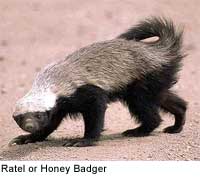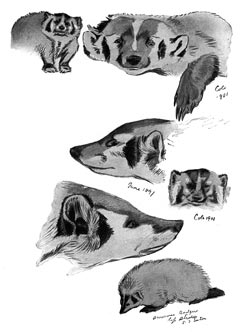|

 Just the Facts: Typical badgers are short-legged and heavy-set. The lower jaw is articulated to the upper, by means of a transverse condyle firmly locked into a long cavity of the cranium, so that dislocation of the jaw is all but impossible. This enables the badger to maintain its hold with the utmost tenacity. Badgers are the largest indigenous carnivores in the UK. Just the Facts: Typical badgers are short-legged and heavy-set. The lower jaw is articulated to the upper, by means of a transverse condyle firmly locked into a long cavity of the cranium, so that dislocation of the jaw is all but impossible. This enables the badger to maintain its hold with the utmost tenacity. Badgers are the largest indigenous carnivores in the UK.

 Formidable: There is a general belief that nothing of comparable size can overcome a badger. Its ferocity, sharp teeth and strong claws make it a formidable foe. The badger's thick hair and loose skin make an armor too tough for other animals to penetrate. And if worse comes to worst, the badger can run backwards as fast as forward! Formidable: There is a general belief that nothing of comparable size can overcome a badger. Its ferocity, sharp teeth and strong claws make it a formidable foe. The badger's thick hair and loose skin make an armor too tough for other animals to penetrate. And if worse comes to worst, the badger can run backwards as fast as forward!
Super Digger: The badger uses its claws to dig. It digs to hunt and to eat. Its success is dependent upon the ability to dig faster than its prey. It also "digs in" to escape intruders but if attacked, can easily defend itself.
Subway System: The badger's grass-lined nest is in a chamber two to five feet underground usually at the end of a tunnel up to 30 feet long. Two to five young are born in the spring. Their eyes open within five weeks, and soon they join their mother on hunting trips.
-----------------------------------------------------------------------------------------------------------------------------
 The Ratel (Mellivora capensis), also known as the Honey Badger, is a member of the Mustelidae family. They are distributed throughout most of Africa and western and south Asia. It is the only species classified in the genus Mellivora and the subfamily Mellivorinae. The Ratel (Mellivora capensis), also known as the Honey Badger, is a member of the Mustelidae family. They are distributed throughout most of Africa and western and south Asia. It is the only species classified in the genus Mellivora and the subfamily Mellivorinae.
Honey Hunters: Ratels have such a great appetite for ravaging beehives that there have been cases of dead ratels being found, stung to death within the hives they were trying to eat. Commercial honey producers do not take kindly to this destruction and sometimes shoot, trap, or poison ratels they suspect of damaging their hives.
Bird/Badger Collaboration: Some sources say that a bird, the honeyguide, has a habit of leading ratels and other large mammals to bees' nests. When a ratel breaks into the nest, the birds take their share too. Other sources say that honeyguides are only known to guide humans. The ratel is among the fiercest hunters of the desert, with prey including earthworms, termites, scorpions, porcupines, hares and even snakes. Its ferocious reputation extends to attacks on animals much larger than itself.
Temper, Temper: Several African tribes report that the honey badger attacks the scrotum of larger mammals if provoked and has even castrated humans. While these reports remain uncorroborated by first-hand evidence, there is some circumstantial evidence such as remains of castrated waterbuck and gnu found in Kruger National Park (dead by blood loss).
The American Badger, Taxidea taxus, is a North American badger, somewhat similar in appearance to the European Badger. It is found in the western and central United States, northern Mexico and central  Canada. This animal prefers dry open areas with deep soils that are easy to dig, such as prairie regions. Canada. This animal prefers dry open areas with deep soils that are easy to dig, such as prairie regions.
Just the Facts: American Badgers have a triangular face with a distinctive black and white pattern and a stocky body covered with shaggy grizzled fur. They have short powerful legs with long sharp claws on the front paws and shorter claws on the back paws.
What's for Dinner? These animals prey on ground squirrels and mice and other small mammals, often digging to pursue prey into their dens. They also eat birds, snakes and insects.
Badger Basics: They are mainly active at night, but may be active during the day. They do not hibernate but may become less active in winter. They are normally solitary animals for most of the year. Males may breed with more than one female.
 The Badgers and the Bees: Mating occurs in the summer, but implantation is delayed and the young are born in an underground burrow during late winter. They have few natural predators other than humans. The numbers of these animals has declined due to persecution by farmers and the extermination of many of their prey in agricultural areas. The Badgers and the Bees: Mating occurs in the summer, but implantation is delayed and the young are born in an underground burrow during late winter. They have few natural predators other than humans. The numbers of these animals has declined due to persecution by farmers and the extermination of many of their prey in agricultural areas.
Eurasian badgers are around 90 cm long (including a 20 cm tail) and weigh 10 kg on average, but weights can vary enormously. In the northern area of the range (only), badgers hibernate and put on fat in the autumn to help them through the winter months. In parts of Russia, badgers may weigh as much as 32 kg in the autumn.
What's for Dinner? Badgers are omnivorous; most of their diet consists of earthworms, although they also eat insects, beetles, small mammals, lizards, frogs, eggs, young birds, berries, roots, bulbs, nuts, fruit, and other plant matter. They also dig up the nests of wasps in order to eat the larvae.
Badgers prefer grazed pasture and woodland, which have high numbers of earthworms exposed, and dislike clay soil, which is difficult to dig even with their powerful claws. In urban areas, some badgers scavenge food from bins and gardens.
Badger Basics: Badgers are nocturnal and spend the day in their setts, extensive networks of tunnels. Setts enable them to survive through very hot or cold weather. They are territorial, but can be found in groups (called clans) of up to 12. Each clan has a dominant male and female which are often (but not always) the only members of the clan to reproduce. Female badgers can display delayed implantation: after mating at any time of the year, they keep the fertilized eggs in suspended development until an appropriate time, at which stage the eggs are implanted and begin developing. Badgers have a gestation period of 7-8 weeks and give birth to 1-5 offspring. Males are called boars and females sows; the young are cubs. Badgers live for up to 15 years (average 3 years) in the wild, and up to 19 years in captivity. If they survive their first year, the most common cause of death is by road traffic.

All text is available under the terms
of the GNU Free Documentation License
|